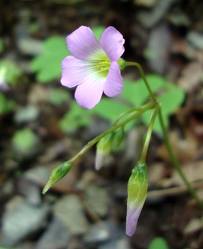Sarracenia
Pot Cultivation
Pitcher Plants need a minimum temperature of 40 degrees. In cool climates, grow as a house or greenhouse plant on damp peat or moss. They should have a location with full sun, since they need at least 6 to 8 hours a day to survive. (The purple Pitcher Plant, however, should receive afternoon shade.) They need a lot of water throughout the year, however, less should be given during the winter. When they are grown outdoors, they need boggy conditions. A soil that is mostly black organic matter and sand is the best. They should be grown 5 or 6 inches above the water level in your bog garden.Propagation
In autumn, seeds can be collected when the seed pods begin to crack or when they turn from green to greenish-yellow or tan. If you gather them before the pods split, they may not be ripe, however, if you wait too long, the seeds may already have fallen. Cut off the ripe capsules and dry in a paper bag on a sheet of paper for a few days, after which they are opened. Sieve the seeds to clean them and store in an airtight jar in the refrigerator. If the seeds are gathered fresh and stored correctly, most will germinate for up to five years after they were gathered. Equal parts of moist peat and coarse vermiculite, which have been watered with a mixture of water and fungicide and allowed to drain completely, should be placed in small pots, which have been sterilized in bleach solution and rinsed well. Sprinkle the seeds on the surface of the soil and lightly press them down. Place the containers in plastic bags and set in the refrigerator for two months. Remove from the refrigerator and the plastic bag and set in a shallow tray of water that reaches a quarter of the way up the pot. Distilled, de-ionized, or rainwater is the best. They will start to sprout 20 to 40 days after they've been taken from the refrigerator. The seedlings should be grown in a greenhouse or other sheltered area for the first year to allow them to become established. Protect them from rain. They can be transplanted outdoors in the spring of the second growing season. They need good ventilation and monthly applications of fungicide. These plants can also be increased by division of the crowns. This is also the easiest method. Carefully break or cut the rhizomes into the individual crowns without damaging the roots. Replant them right away. |
S. Drummondi |
VARIETIES
- S. flava;
- S. Drummondi (P. green & purple splotched w/ white, F. greenish-purple);
- S. purpurea (P. purple, F. greenish-purple);
- S. Claytonii (P. purple, F. purplish);
- S. rubra (P. green w/ purple veins, F. crimson);
- S. psittacina (P. green w/ purple w/ white veins, F. greenish-purple).




